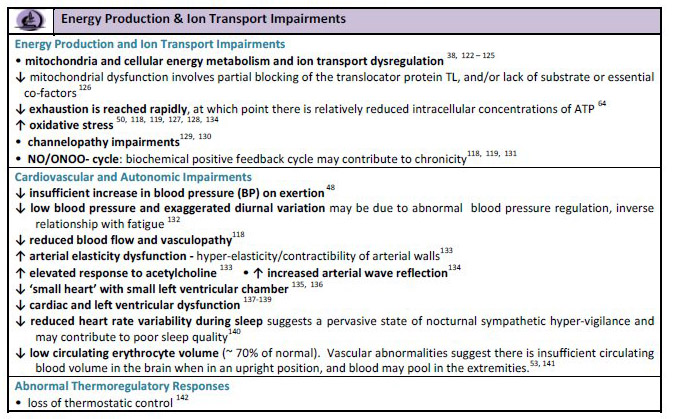| Micro Circulation Defects
Scientific and Medical Evidence
Cardiac
and Vascular and Blood vessel problems. Increased risk of heart attack
Orthostatic intolerance & Postural orthostatic tachycardia syndrome (POTS) & Body fluid
abnormalities
Abnormal red blood cell structure
Peckerman A, et al. Abnormal impedance cardiography predicts symptom severity in chronic fatigue syndrome. Am J Med Sci 2003 Aug;326(2):55-60.
Dr. Martin Lerner's lecture on clinical findings
Video lecture by Dr. Paul Cheney on cardiomyopathy findings in ME
Markedly Impaired Cardiac Function in Chronic Fatigue Syndrome. Hollingsworth KG, Hodgson T, Macgowan GA, Blamire AM, Newton JL.: J Intern Med. 2011 Jul 27.
Tests
- Specific Tests and Biomarkers mentioned in ME Primer for Healthcare Professionals: based on Myalgic encephalomyelitis: International Consensus Criteria, 2012

Also use Canadian Criteria 2003 http://www.me-ireland.com/canada-overview.pdf
- Abnormal red blood cell structure and it's effects on micro-circulation. Some scientific studies have found abnormal red blood cell structure in most ME patients. This causes a reduction in circulation, in oxygen and nutrient uptake in cells, and deficient excretion of waste matter from cells. This depletes and damages the cells, the mitochondria and the tissues and organs over time, and causes a build up of toxins and free radicals. These are major factors in ME. The details of this abnormality are outlined in the following research studies.
- L. O. Simpson, 'The Role of Nondisocytic Erythrocytes in the Pathogenesis of Myalgic Encephalomyelitis / Chronic Fatigue Syndrome', The Clinical and Scientific Basis of ME/ CFS [Ottawa, Ontario: The Nightingale Research Foundation, 1992], p. 597
- Mukherjee TM, Smith K, Maros K. Abnormal red-blood-cell morphology in myalgic en-cephalomyelitis. Lancet 1987;2:328-329.20. Simpson LO. Nondiscocytic erythrocytes inmyalgic encephalomyelitis. N Z Med J 1989;102:126-127.21.
- Simpson LO, Murdoch JC, Herbison GP. Red cell shape changes following trigger finger fatigue in subjects with chronic tiredness and healthy controls. N Z Med J 1993;106:104-107
- Dr. Byron Hyde one of the top ME doctors in the world recommends several vascular and circulation tests for ME
- Serum viscosity test
- Antiphospholipid Ab
- Protein C defects
- Protein S defects
- Factor V Leiden defect
- Test for Vasculitis.
- Check for diffuse inflammatory injury of the capillaries at the level of the basement membrane of the brain
- Raynaud's Disease: vasoconstriction, blanching, coldness and pain of extremities.
- Infectious Venulitis
Dr. Erich Ryll who is a medical doctor and Professor of Medicine at the University of California, Davis, closely studied Infectious Venulitis since the 1970's and he found many similarities between this illness and ME and CFS. He also studied and examined cases in other countries and found similar results. He believes that a virus is responsible for systemic damage to the body and in particular the vascular system and veins.
Diagnostics - Inflammation of veins, including deep veins. Small haemorrhages around blood vessels in the cerebral cortex extending into the mid-brain, and other areas of the brain. Diffuse micro-haemorrhagic injury of the brain and this occurring around the small blood vessels. Signs of slight vein breakages, minor haemmorhages in different body areas. Easy bruising. Some minor dy-myelination in the brain. Brain hypo-perfusion. Excess pro-inflammatory TH2 cytokines. Difficulty sleeping, unrefreshing sleep. Diffuse pain, headaches, dizziness, brain fog. Poor circulation and feeling cold.
The following articles provide information about this condition
.- Infectious Venulitis, Dr. Erich Ryll
- Simialrities between ME and Infectious Venulitis
- Numerous small haemorrhages around blood vessels in the cerebral cortex extending into the mid-brain (post-mortem of English ME patient Andrew Wallis in 1955)
-
Vasculitis involving the skin was recorded during outbreaks in Cumberland, Durham and North West London in 1955. A maculopapular rash may appear during the return of features of the initial illness such as flu-like symptoms and enlargement of lymph glands and liver.
- Test for Erythrocyte sedimentation rate. The rate is usually very low or zero in ME patients. Canadian clinician Byron Hyde reported in the fall 1989 issue of his newsletter to sufferers, “To my knowledge, there are only five diseases that have a pathological low sedimentation level: myalgic encephalomyelitis (ME also called CFS), sickle-cell anemia, hereditary sperocytosis, hyper-gammaglobulinemia, hyper-fibrogenemia.”
|

